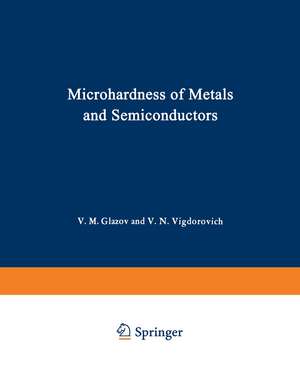Microhardness of Metals and Semiconductors
Autor V. M. Glazoven Limba Engleză Paperback – 12 iun 2012
Preț: 391.22 lei
Nou
Puncte Express: 587
Preț estimativ în valută:
74.88€ • 77.88$ • 62.75£
74.88€ • 77.88$ • 62.75£
Carte tipărită la comandă
Livrare economică 13-27 martie
Preluare comenzi: 021 569.72.76
Specificații
ISBN-13: 9781468482485
ISBN-10: 1468482483
Pagini: 244
Ilustrații: XVI, 226 p.
Dimensiuni: 203 x 254 x 13 mm
Greutate: 0.49 kg
Ediția:Softcover reprint of the original 1st ed. 1971
Editura: Springer Us
Colecția Springer
Locul publicării:New York, NY, United States
ISBN-10: 1468482483
Pagini: 244
Ilustrații: XVI, 226 p.
Dimensiuni: 203 x 254 x 13 mm
Greutate: 0.49 kg
Ediția:Softcover reprint of the original 1st ed. 1971
Editura: Springer Us
Colecția Springer
Locul publicării:New York, NY, United States
Public țintă
ResearchCuprins
1. Apparatus and Method of Measuring Microhardness.- The PMT-3 Apparatus.- Determining the Scale of Microscope Magnification.- Adjusting and Calibrating the Apparatus.- Measuring the Diagonal of the Impression and Determining the Value of the Microhardness.- Some Special Cases of Using the Devices for Measuring Microhardness.- 2. Techniques of Determining Microhardness.- Evaluating the Object and Choosing the Point for Studying Microhardness.- Choice of Load.- Choice of Loading Time and Period under Load.- Measuring Microhardness with Automatic Sample Loading.- Effect of Vibrations on Microhardness.- Estimating Errors in Measuring Microhardness.- 3. Method of Preparing Samples for Study.- Effect of Structure.- Effect of the Particular State of the Surface Layer.- Chemical Treatment of the Surface of Microsections.- 4. Aspects of the Method of Measuring the Microhardness of Semiconductors.- Anisotropy of Microhardness.- Dislocation Density.- Microbrittleness.- 5. Relation between the Microhardness of Solid-Solution Crystals and the Composition of the Alloy in Two-Component Systems.- Theoretical Microhardness/Composition Relation in Two-Component Systems.- The Microhardness Method in Plotting Limited-Solubility Curves on Phase Diagrams of Two-Component Systems.- The Microhardness Method in Plotting Solidus Lines on the Phase Diagrams of Two-Component Systems.- Microhardness in Two-Component Semiconducting Systems.- Determining Ranges of Homogeneity Based on Semiconducting Compounds, Using the Microhardness Method.- Distribution of Alloying (Doping) Elements in the Production of Single Crystals.- Study of Diffusion Processes in Alloys.- 6. Use of the Microhardness Method in Studying the Phase Diagrams and Structure of Three-Component Alloys.- Some Theoretical Premises.- Construction of a Limited-Solubility Surface and a Solidus Surface.- Effect of the Deviations of the Sections Studied from the Conodes on the Character of the Microhardness/Composition Relationships.- Additivity of the Microhardness Increment in the Form-Ternary and More Complex Solid Solutions.- Use of the Microhardness Method in Plotting Conodes in Two-Phase Regions of Ternary Phase Diagrams.- Chemical Interaction between Alloying Components in Ternary Solid Solutions Based on Metals and Semiconductors.- 7. Use of the Microhardness Method in Studying the Phase Diagrams of Quaternary Systems.- Plotting the Boundaries between Phase Regions in Quaternary Systems.- Plotting Conodes in the Two-Phase Volumes of Quaternary Phase Diagrams.- 8. Use of the Microhardness Method for Studying Liquation Phenomena in Alloys.- Essence of the Phenomena of Dendritic Liquation and Indicators of the Chemical Microinhomogeneity of Alloys.- Study of Chemical Microinhomogeneity in Alloys by the Microhardness Method.- Dependence of the Indicators of Chemical Microinhomogeneity in Alloys on the Rate of Cooling during Crystallization.- Kinetic Characteristics of Dendritic Liquation in Metallic Alloys.- Effect of the Superheating of the Melt on the Development of Liquation Microinhomogeneities in Alloys.- Crystallization Effect in the Quenching of Alloys from the Region of the Intermediate Solid-Liquid State.- 9. Microheterogenization of Solid-Solution Crystals in Two-Phase Alloys.- Relation between the Microhardness of Solid-Solution Crystals and the Composition of the Two-Phase Alloys.- Two Mechanisms of the Microheterogenization of Solid-Solution Crystals in Two-Phase Alloys.- Possible Existence of a Third Mechanism for the Microheterogenization of Solid-Solution Crystals in Two-Phase Alloys.-Effect of Cooling Rate on the Microhardness of Heterogenized Solid-Solution Crystals of Two-Phase Alloys.- Kinetics of the Transformation of Quasihomogeneous Solid-Solution Crystals of Two-Phase Alloys into the Truly Homogeneous State.- Nature of Microheterogeneity.- 10. Microhardness of Individual Phases and Structural Constituents of Metallic Alloys.- The Microhardness Method for Studying the Structural Components of Nonferrous Alloys.- The Microhardness Method for Studying the Structure and Properties of Steels and Cast Irons.- The Microhardness of Refractory Compounds.- 11. Microhardness of Semiconducting Materials.- Microhardness of Semiconducting Materials of Various Groups.- The Microhardness of Chemical Elements and Compounds and Their Crystal- Chemical Properties.- References.














